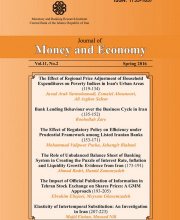
Journal of Money and Economy
Journal of Money and Economy, Vol. 18 No. 2, Spring 2023 (مقاله علمی وزارت علوم)
مقالات
حوزههای تخصصی:
The healthcare system holds a significance role in economic growth and development of any country. For assessing and evaluating the healthcare system, the relative prices of this sector are one of the crucial indicator. This study employs a stochastic dynamic general equilibrium model to examine the impacts of monetary, fiscal and technology shocks on the healthcare sector in the Iranian economy. The results indicate that positive monetary shock has direct impact on general inflation but tends to be reduced the relative prices of the health sector. Thus, the positive impact of this shock on the production of non-health goods is greater than the health sector. Also, positive shocks related to oil income, government health sector expenditures, and technology increase the production of health and non-health goods and have an inverse effect on inflation of this sector.
Effectiveness of Central Bank Digital Currency: A Survey(مقاله علمی وزارت علوم)
حوزههای تخصصی:
Technological advancement in recent years has compelled central banks to look for new ways to effectively provide payment systems that are fast and more convenient compared to traditional paper-based payment systems. It has led to the birth of the concept of digital currencies issued solely by central banks called Central Bank Digital Currency (CBDC). As this concept is relatively new, there is ongoing research being conducted by several central banks worldwide, and while the research work done thus far has answered many questions, there remains a number of unsettled issues and questions. This paper aims to delve into the literature on this concept and focus on several key questions like the reasons for issuing digital currency, payment systems efficiency, and the advantages and disadvantages of digital currencies issued by central banks. Answering these questions could substantially help figure out the usefulness of creating a new payment method alongside the current payment system. However, extensive future research is required for a comprehensive understanding the effectiveness and usefulness of digital currencies.
Identifying and Prioritizing Systematic Risk Indicators on the Rate of Return in Investment Companies(مقاله علمی وزارت علوم)
حوزههای تخصصی:
Existing models do not adequately capture how changes in the external environment (systematic risk) affect corporate returns. This study addresses this gap by identifying explanatory variables and an experimental model design. The sample includes 16 investment companies over two periods, 2006-1 and 2020-4. We inputted 69 systematic risk variables into the model and identified the 1-12 non-fragile variables affecting investment company weighted averages using a Bayesian model averaging approach. The findings show that the non-official hard currency exchange rate is the most robust variable influencing the Tehran Stock Exchange. Thus, stocks with the highest correlation to the foreign exchange rate should be selected when forming a portfolio. Moreover, fiscal policy variables directly impact investment company weighted average returns. Consequently, portfolios of quasi/semi-government-owned companies will see higher return fluctuations.
The Role of Bank Capital in the Propagation of Shocks in Iran: A Dynamic Stochastic General Equilibrium Approach(مقاله علمی وزارت علوم)
حوزههای تخصصی:
Considering the intermediary role of banks in the economy and their critical function in the propagation of economic shocks to the real sector, this study aims to investigate the role of bank capital in analyzing the relationship between banks' balance sheet characteristics and economic fluctuations using a Dynamic Stochastic General Equilibrium (DSGE) model. The results demonstrate that, in the model with a bank capital channel, positive shocks lead to more robust economic growth. This is attributed to the banks' ability to invest, enhancing the positive effects of shocks. Taking bank capital into account, variables such as consumption, and inflation exhibit better performance, with reduced fluctuations or quicker adjustments, leading to economic stability. Conversely, in an economic scenario without a bank capital channel, positive shocks have a lesser impact on economic variables. Consequently, the results can effectively inform decision-making regarding the necessity of adhering to bank capital adequacy ratios.
Credit Benefit of Reverse Factoring in Iran: An Agent-Based Approach(مقاله علمی وزارت علوم)
حوزههای تخصصی:
We investigate the effects of the implementation of reverse factoring on the credit risk level of financially constrained suppliers within a supply chain. To simulate the desired supply chain finance environment, an agent-based framework is developed. Short-term bank financing and reverse factoring are available financial instruments for suppliers. The estimations regarding the default probability of agents are calculated using formulations of the KMV (Kealhofer Merton Vasicek) model. It incorporates market-based information and company-specific financial data to estimate the likelihood of default and potential losses based on the estimation of the market value and volatility of the firm’s asset and calculation of the distance to default. Results suggest that the adoption of reverse factoring significantly alleviates the credit risk levels of financially constrained members of a certain layer within a supply chain.
Modeling the Dynamic Correlations among Cryptocurrencies: New Evidence from Multivariate Factor Stochastic Volatility Model(مقاله علمی وزارت علوم)
حوزههای تخصصی:
This paper intends to model the volatilities of returns of 20 different cryptocurrencies using daily data from 08/03/2018 to 09/20/2022. The multivariate factor stochastic volatility model (MFSV) within the framework of the nonlinear space-state approach is used. In this method, the cryptocurrency return volatility is decomposed into volatility rooted in latent factors and idiosyncratic volatility, and the time-varying pairwise correlation and dynamic covariance matrix are estimated in four sub-periods. The MFSV model’s results revealed that each sub-period contains a distinct number of latent factors, 2, 5, 4 and 2, which generally have a favorable impact on all cryptocurrency volatilities. The time-varying positive correlations between the return volatility of all cryptocurrencies are confirmed. Indeed, the strongest pairwise correlations belong to Ethereum, Litcoin, EOS, and VET in each sub-period, respectively. The DOGE, DOGE, Filecoin, and XRP, on the other hand, showedthe weakest correlations . As the pairwise correlations of cryptocurrency volatilities get strenger, especially during descending periods, it seems that the benefits of diversifying a crypto portfolio are getting less and less over time.